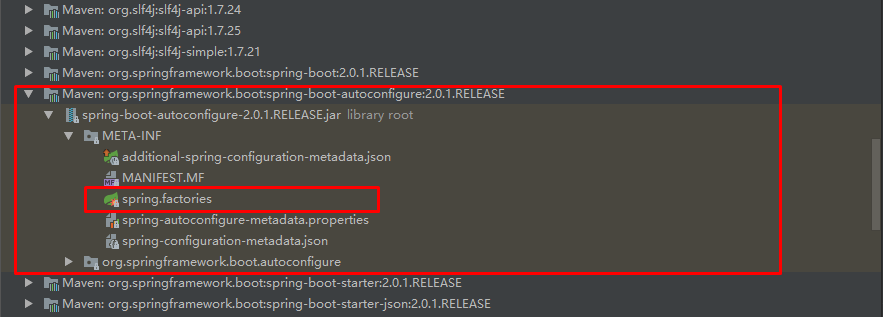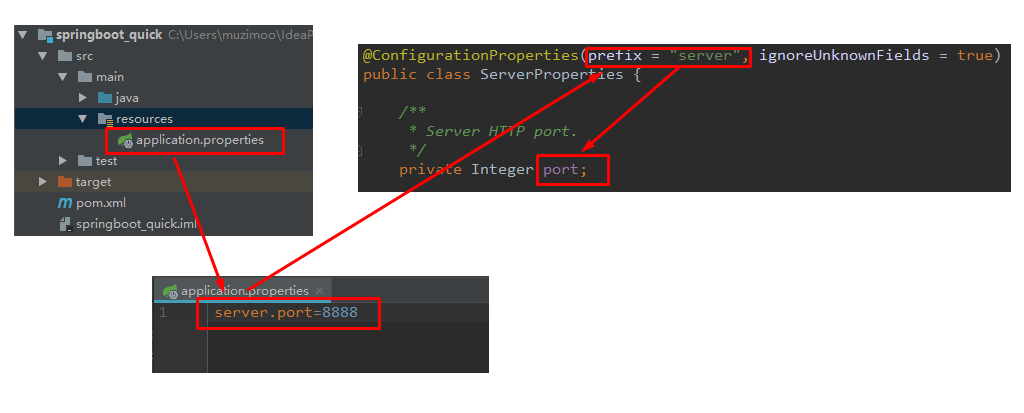1. 起步依赖原理分析
1.1,分析 spring-boot-starter-parent
按住 Ctrl 点击 pom.xml 中的 spring-boot-starter-parent,跳转到了 spring-boot-starter-parent 的 pom.xml,xml 配置如下(只摘抄了部分重点配置):
<parent> <groupId>org.springframework.boot</groupId> <artifactId>spring-boot-dependencies</artifactId> <version>2.0.1.RELEASE</version> <relativePath>../../spring-boot-dependencies</relativePath></parent>
复制代码
按住 Ctrl 点击 pom.xml 中的 spring-boot-starter-dependencies,跳转到了 spring-boot-starter-dependencies 的 pom.xml,xml 配置如下(只摘抄了部分重点配置):
<properties> <activemq.version>5.15.3</activemq.version> <antlr2.version>2.7.7</antlr2.version> <appengine-sdk.version>1.9.63</appengine-sdk.version> <artemis.version>2.4.0</artemis.version> <aspectj.version>1.8.13</aspectj.version> <assertj.version>3.9.1</assertj.version> <atomikos.version>4.0.6</atomikos.version> <bitronix.version>2.1.4</bitronix.version> <build-helper-maven-plugin.version>3.0.0</build-helper-maven-plugin.version> <byte-buddy.version>1.7.11</byte-buddy.version> ... ... ...</properties><dependencyManagement> <dependencies> <dependency> <groupId>org.springframework.boot</groupId> <artifactId>spring-boot</artifactId> <version>2.0.1.RELEASE</version> </dependency> <dependency> <groupId>org.springframework.boot</groupId> <artifactId>spring-boot-test</artifactId> <version>2.0.1.RELEASE</version> </dependency> ... ... ... </dependencies></dependencyManagement><build> <pluginManagement> <plugins> <plugin> <groupId>org.jetbrains.kotlin</groupId> <artifactId>kotlin-maven-plugin</artifactId> <version>${kotlin.version}</version> </plugin> <plugin> <groupId>org.jooq</groupId> <artifactId>jooq-codegen-maven</artifactId> <version>${jooq.version}</version> </plugin> <plugin> <groupId>org.springframework.boot</groupId> <artifactId>spring-boot-maven-plugin</artifactId> <version>2.0.1.RELEASE</version> </plugin> ... ... ... </plugins> </pluginManagement></build>
复制代码
从上面的spring-boot-starter-dependencies的 pom.xml 中我们可以发现,一部分坐标的版本、依赖管理、插件管理已经定义好,所以我们的 SpringBoot 工程继承spring-boot-starter-parent后已经具备版本锁定等配置了。所以起步依赖的作用就是进行依赖的传递。
1.2 分析 spring-boot-starter-web
按住 Ctrl 点击 pom.xml 中的 spring-boot-starter-web,跳转到了 spring-boot-starter-web 的 pom.xml,xml 配置如下(只摘抄了部分重点配置):
<?xml version="1.0" encoding="UTF-8"?><project xsi:schemaLocation="http://maven.apache.org/POM/4.0.0 http://maven.apache.org/xsd/maven-4.0.0.xsd" xmlns="http://maven.apache.org/POM/4.0.0" xmlns:xsi="http://www.w3.org/2001/XMLSchema-instance"> <modelVersion>4.0.0</modelVersion> <parent> <groupId>org.springframework.boot</groupId> <artifactId>spring-boot-starters</artifactId> <version>2.0.1.RELEASE</version> </parent> <groupId>org.springframework.boot</groupId> <artifactId>spring-boot-starter-web</artifactId> <version>2.0.1.RELEASE</version> <name>Spring Boot Web Starter</name> <dependencies> <dependency> <groupId>org.springframework.boot</groupId> <artifactId>spring-boot-starter</artifactId> <version>2.0.1.RELEASE</version> <scope>compile</scope> </dependency> <dependency> <groupId>org.springframework.boot</groupId> <artifactId>spring-boot-starter-json</artifactId> <version>2.0.1.RELEASE</version> <scope>compile</scope> </dependency> <dependency> <groupId>org.springframework.boot</groupId> <artifactId>spring-boot-starter-tomcat</artifactId> <version>2.0.1.RELEASE</version> <scope>compile</scope> </dependency> <dependency> <groupId>org.hibernate.validator</groupId> <artifactId>hibernate-validator</artifactId> <version>6.0.9.Final</version> <scope>compile</scope> </dependency> <dependency> <groupId>org.springframework</groupId> <artifactId>spring-web</artifactId> <version>5.0.5.RELEASE</version> <scope>compile</scope> </dependency> <dependency> <groupId>org.springframework</groupId> <artifactId>spring-webmvc</artifactId> <version>5.0.5.RELEASE</version> <scope>compile</scope> </dependency> </dependencies></project>
复制代码
从上面的spring-boot-starter-web的 pom.xml 中我们可以发现,spring-boot-starter-web就是将 web 开发要使用的 spring-web、spring-webmvc 等坐标进行了“打包”,这样我们的工程只要引入spring-boot-starter-web起步依赖的坐标就可以进行 web 开发了,同样体现了依赖传递的作用。
2 .自动配置原理解析
按住 Ctrl 点击查看启动类MySpringBootApplication上的注解@SpringBootApplication
@SpringBootApplicationpublic class MySpringBootApplication { public static void main(String[] args) { SpringApplication.run(MySpringBootApplication.class); }}
复制代码
注解@SpringBootApplication的源码
@Target(ElementType.TYPE)@Retention(RetentionPolicy.RUNTIME)@Documented@Inherited@SpringBootConfiguration@EnableAutoConfiguration@ComponentScan(excludeFilters = { @Filter(type = FilterType.CUSTOM, classes = TypeExcludeFilter.class), @Filter(type = FilterType.CUSTOM, classes = AutoConfigurationExcludeFilter.class) })public @interface SpringBootApplication {
/** * Exclude specific auto-configuration classes such that they will never be applied. * @return the classes to exclude */ @AliasFor(annotation = EnableAutoConfiguration.class) Class<?>[] exclude() default {};
... ... ...
}
复制代码
其中,
@SpringBootConfiguration:等同与 @Configuration,既标注该类是 Spring 的一个配置类
@EnableAutoConfiguration:SpringBoot 自动配置功能开启
按住 Ctrl 点击查看注解 @EnableAutoConfiguration
@Target(ElementType.TYPE)@Retention(RetentionPolicy.RUNTIME)@Documented@Inherited@AutoConfigurationPackage@Import(AutoConfigurationImportSelector.class)public @interface EnableAutoConfiguration { ... ... ...}
复制代码
其中,@Import(AutoConfigurationImportSelector.class) 导入了AutoConfigurationImportSelector类
按住 Ctrl 点击查看AutoConfigurationImportSelector源码
public String[] selectImports(AnnotationMetadata annotationMetadata) { ... ... ... List<String> configurations = getCandidateConfigurations(annotationMetadata, attributes); configurations = removeDuplicates(configurations); Set<String> exclusions = getExclusions(annotationMetadata, attributes); checkExcludedClasses(configurations, exclusions); configurations.removeAll(exclusions); configurations = filter(configurations, autoConfigurationMetadata); fireAutoConfigurationImportEvents(configurations, exclusions); return StringUtils.toStringArray(configurations);}
protected List<String> getCandidateConfigurations(AnnotationMetadata metadata, AnnotationAttributes attributes) { List<String> configurations = SpringFactoriesLoader.loadFactoryNames( getSpringFactoriesLoaderFactoryClass(), getBeanClassLoader()); return configurations;}
复制代码
其中,SpringFactoriesLoader.loadFactoryNames 方法的作用就是从META-INF/spring.factories文件中读取指定类对应的类名称列表
spring.factories 文件中有关自动配置的配置信息如下:
... ... ...
org.springframework.boot.autoconfigure.web.reactive.function.client.WebClientAutoConfiguration,\org.springframework.boot.autoconfigure.web.servlet.DispatcherServletAutoConfiguration,\org.springframework.boot.autoconfigure.web.servlet.ServletWebServerFactoryAutoConfiguration,\org.springframework.boot.autoconfigure.web.servlet.error.ErrorMvcAutoConfiguration,\org.springframework.boot.autoconfigure.web.servlet.HttpEncodingAutoConfiguration,\org.springframework.boot.autoconfigure.web.servlet.MultipartAutoConfiguration,\
... ... ...
复制代码
上面配置文件存在大量的以 Configuration 为结尾的类名称,这些类就是存有自动配置信息的类,而 SpringApplication 在获取这些类名后再加载
我们以ServletWebServerFactoryAutoConfiguration为例来分析源码:
@Configuration@AutoConfigureOrder(Ordered.HIGHEST_PRECEDENCE)@ConditionalOnClass(ServletRequest.class)@ConditionalOnWebApplication(type = Type.SERVLET)@EnableConfigurationProperties(ServerProperties.class)@Import({ ServletWebServerFactoryAutoConfiguration.BeanPostProcessorsRegistrar.class, ServletWebServerFactoryConfiguration.EmbeddedTomcat.class, ServletWebServerFactoryConfiguration.EmbeddedJetty.class, ServletWebServerFactoryConfiguration.EmbeddedUndertow.class })public class ServletWebServerFactoryAutoConfiguration { ... ... ...}
复制代码
其中,
@EnableConfigurationProperties(ServerProperties.class) 代表加载 ServerProperties 服务器配置属性类
进入 ServerProperties.class 源码如下:
@ConfigurationProperties(prefix = "server", ignoreUnknownFields = true)public class ServerProperties {
/** * Server HTTP port. */ private Integer port;
/** * Network address to which the server should bind. */ private InetAddress address; ... ... ... }
复制代码
其中,prefix = "server" 表示 SpringBoot 配置文件中的前缀,SpringBoot 会将配置文件中以 server 开始的属性映射到该类的字段中。映射关系如下:
我是【程序员的时光】,热爱技术分享,SpringBoot 系列会天天更新,欢迎大家关注!我们下期再见!















评论